Commercial and Corporation Law Report
VerifiedAdded on 2020/02/23
|8
|1739
|78
Report
AI Summary
This report delves into the complexities of commercial and corporation law, particularly focusing on shareholder rights regarding dividend payments. It discusses the legal obligations of directors under the Corporation Act 2011 in Australia, highlighting a case study involving the Galli grandchildren's grievances against the board of directors for withholding dividends. The report also examines share buybacks and capital reduction processes, providing a comprehensive overview of the relevant legal frameworks and implications for shareholders.
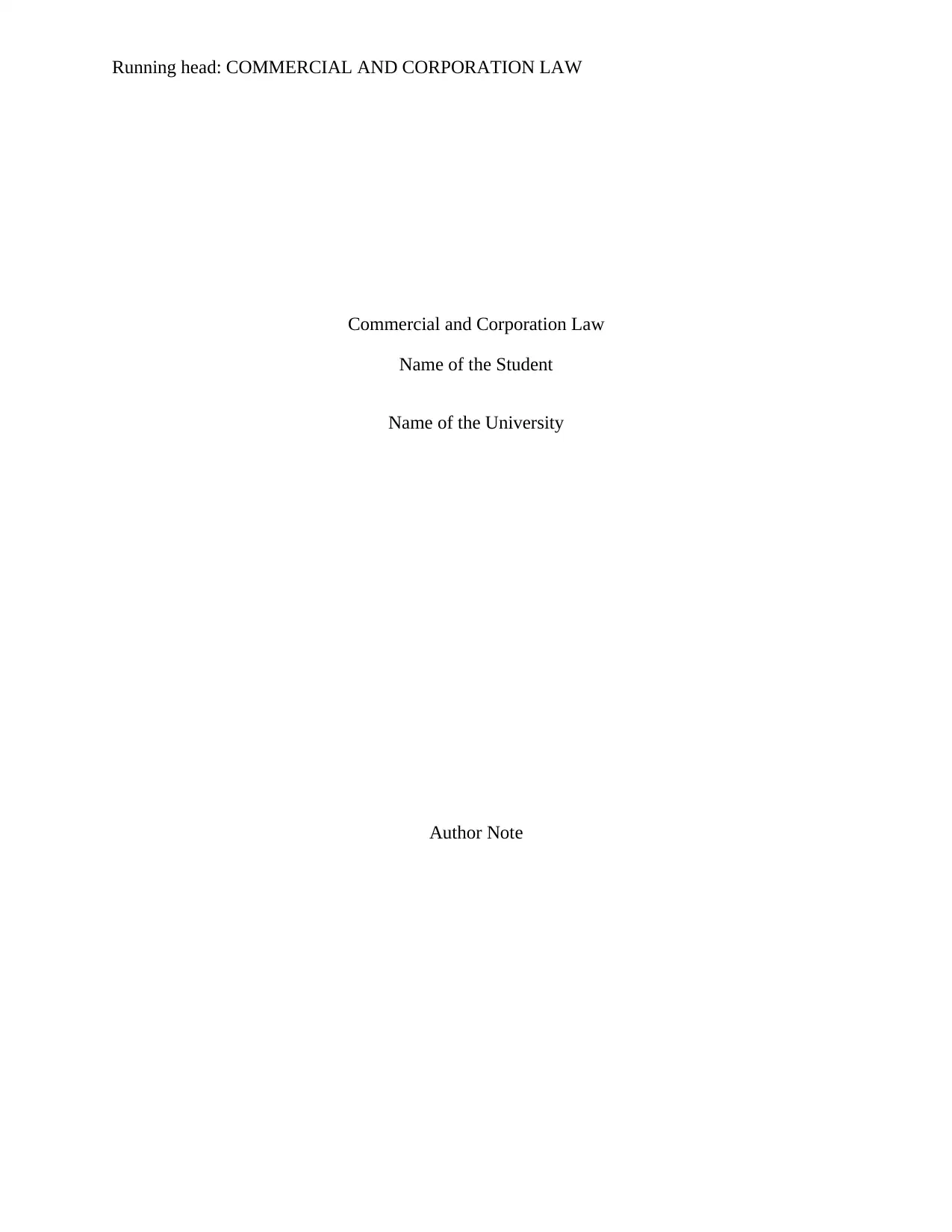
Running head: COMMERCIAL AND CORPORATION LAW
Commercial and Corporation Law
Name of the Student
Name of the University
Author Note
Commercial and Corporation Law
Name of the Student
Name of the University
Author Note
Paraphrase This Document
Need a fresh take? Get an instant paraphrase of this document with our AI Paraphraser
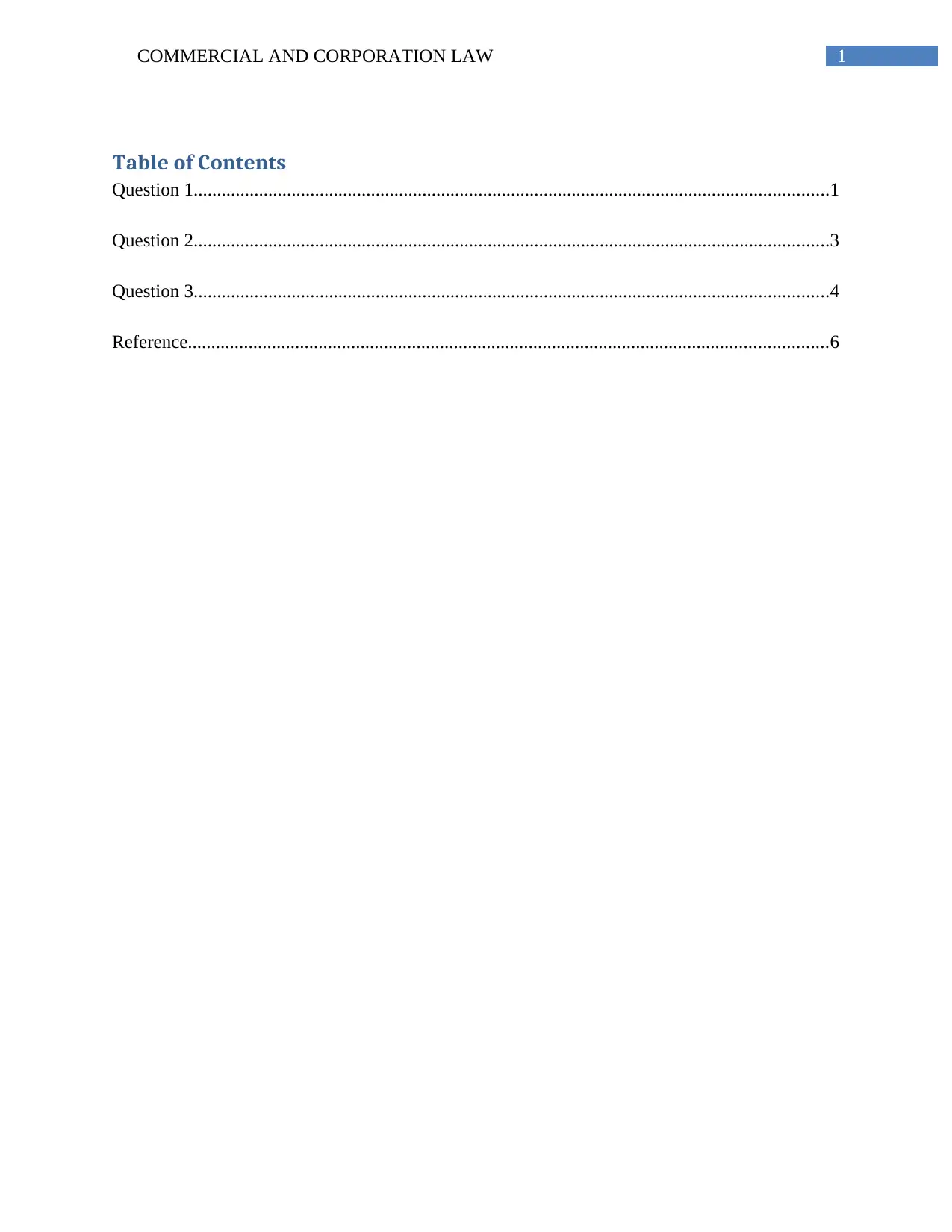
1COMMERCIAL AND CORPORATION LAW
Table of Contents
Question 1........................................................................................................................................1
Question 2........................................................................................................................................3
Question 3........................................................................................................................................4
Reference.........................................................................................................................................6
Table of Contents
Question 1........................................................................................................................................1
Question 2........................................................................................................................................3
Question 3........................................................................................................................................4
Reference.........................................................................................................................................6
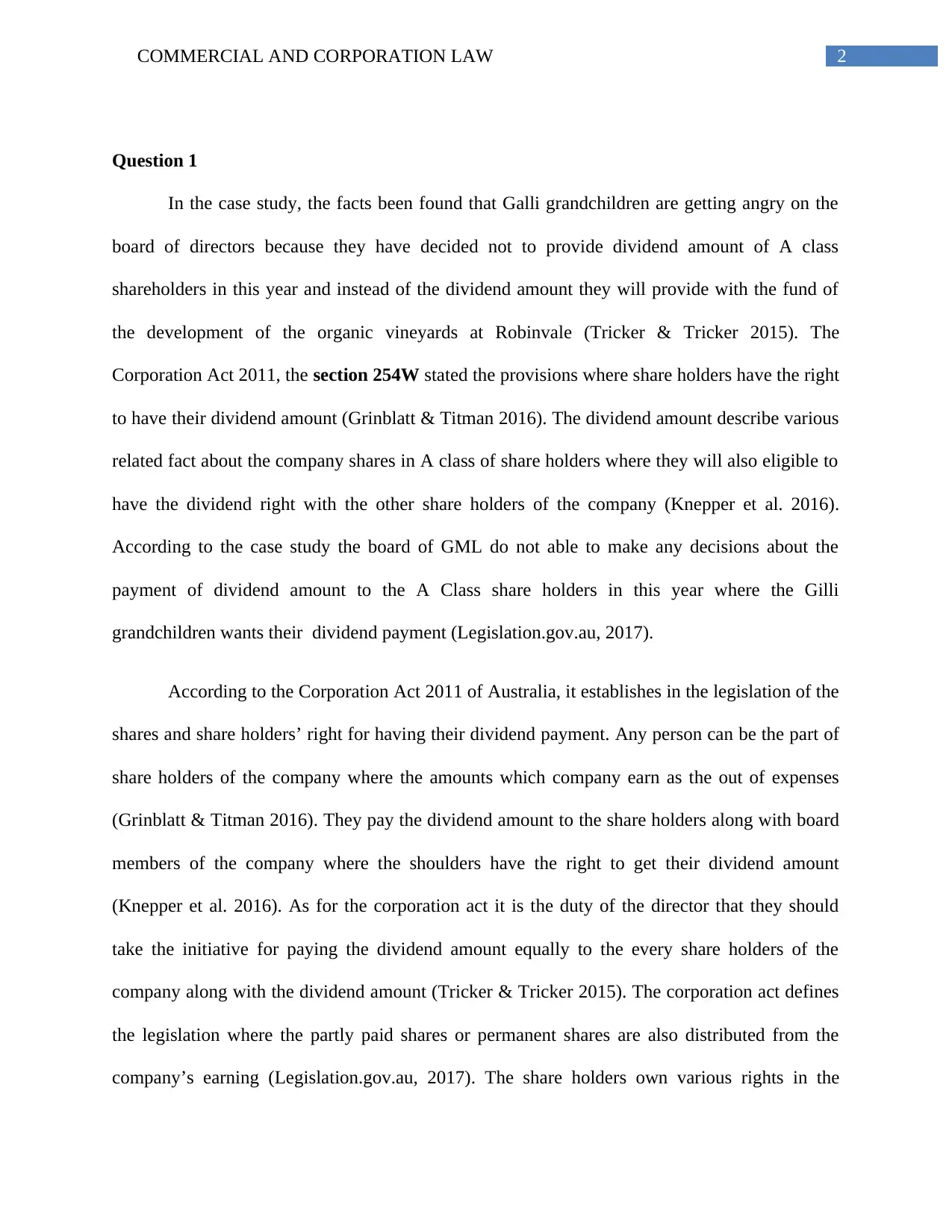
2COMMERCIAL AND CORPORATION LAW
Question 1
In the case study, the facts been found that Galli grandchildren are getting angry on the
board of directors because they have decided not to provide dividend amount of A class
shareholders in this year and instead of the dividend amount they will provide with the fund of
the development of the organic vineyards at Robinvale (Tricker & Tricker 2015). The
Corporation Act 2011, the section 254W stated the provisions where share holders have the right
to have their dividend amount (Grinblatt & Titman 2016). The dividend amount describe various
related fact about the company shares in A class of share holders where they will also eligible to
have the dividend right with the other share holders of the company (Knepper et al. 2016).
According to the case study the board of GML do not able to make any decisions about the
payment of dividend amount to the A Class share holders in this year where the Gilli
grandchildren wants their dividend payment (Legislation.gov.au, 2017).
According to the Corporation Act 2011 of Australia, it establishes in the legislation of the
shares and share holders’ right for having their dividend payment. Any person can be the part of
share holders of the company where the amounts which company earn as the out of expenses
(Grinblatt & Titman 2016). They pay the dividend amount to the share holders along with board
members of the company where the shoulders have the right to get their dividend amount
(Knepper et al. 2016). As for the corporation act it is the duty of the director that they should
take the initiative for paying the dividend amount equally to the every share holders of the
company along with the dividend amount (Tricker & Tricker 2015). The corporation act defines
the legislation where the partly paid shares or permanent shares are also distributed from the
company’s earning (Legislation.gov.au, 2017). The share holders own various rights in the
Question 1
In the case study, the facts been found that Galli grandchildren are getting angry on the
board of directors because they have decided not to provide dividend amount of A class
shareholders in this year and instead of the dividend amount they will provide with the fund of
the development of the organic vineyards at Robinvale (Tricker & Tricker 2015). The
Corporation Act 2011, the section 254W stated the provisions where share holders have the right
to have their dividend amount (Grinblatt & Titman 2016). The dividend amount describe various
related fact about the company shares in A class of share holders where they will also eligible to
have the dividend right with the other share holders of the company (Knepper et al. 2016).
According to the case study the board of GML do not able to make any decisions about the
payment of dividend amount to the A Class share holders in this year where the Gilli
grandchildren wants their dividend payment (Legislation.gov.au, 2017).
According to the Corporation Act 2011 of Australia, it establishes in the legislation of the
shares and share holders’ right for having their dividend payment. Any person can be the part of
share holders of the company where the amounts which company earn as the out of expenses
(Grinblatt & Titman 2016). They pay the dividend amount to the share holders along with board
members of the company where the shoulders have the right to get their dividend amount
(Knepper et al. 2016). As for the corporation act it is the duty of the director that they should
take the initiative for paying the dividend amount equally to the every share holders of the
company along with the dividend amount (Tricker & Tricker 2015). The corporation act defines
the legislation where the partly paid shares or permanent shares are also distributed from the
company’s earning (Legislation.gov.au, 2017). The share holders own various rights in the
⊘ This is a preview!⊘
Do you want full access?
Subscribe today to unlock all pages.

Trusted by 1+ million students worldwide
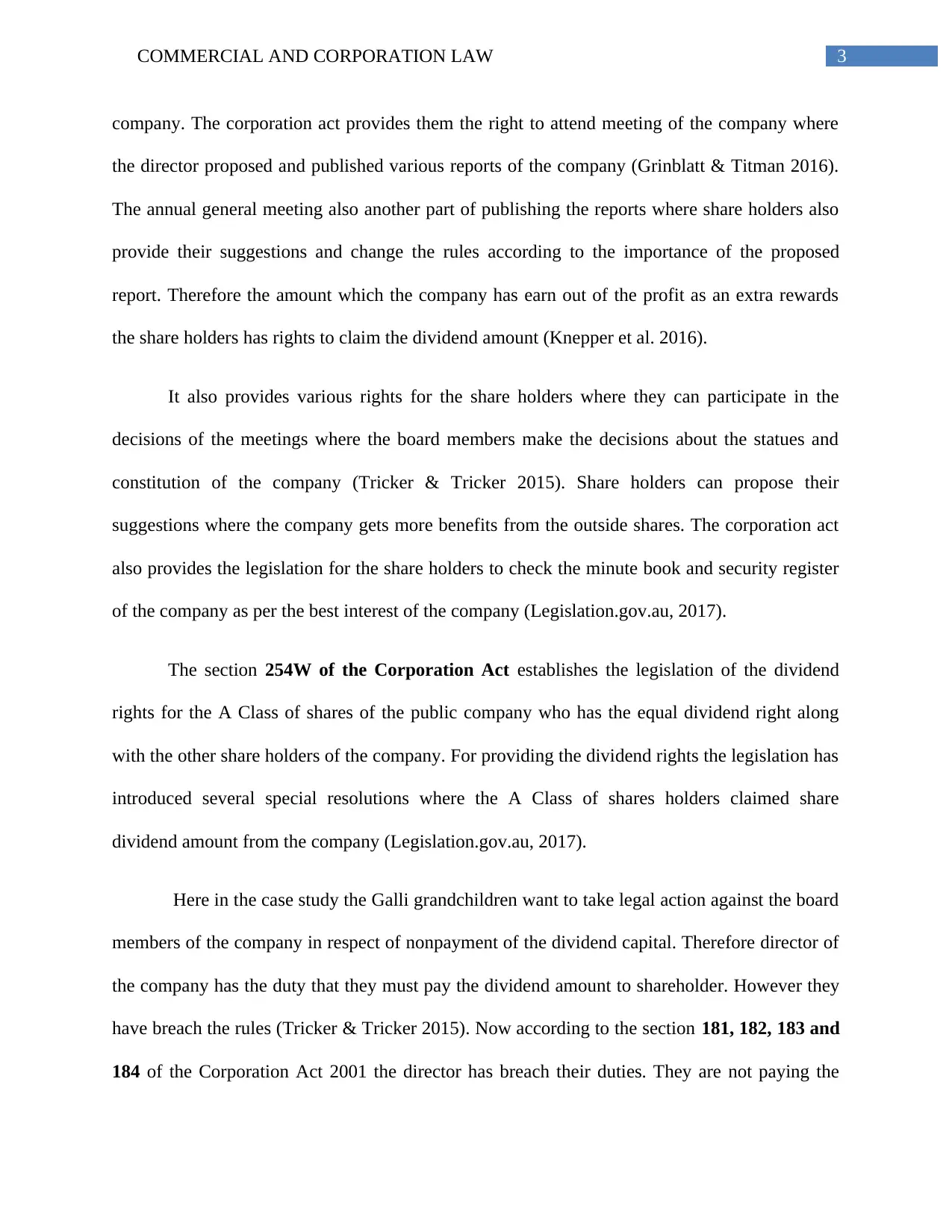
3COMMERCIAL AND CORPORATION LAW
company. The corporation act provides them the right to attend meeting of the company where
the director proposed and published various reports of the company (Grinblatt & Titman 2016).
The annual general meeting also another part of publishing the reports where share holders also
provide their suggestions and change the rules according to the importance of the proposed
report. Therefore the amount which the company has earn out of the profit as an extra rewards
the share holders has rights to claim the dividend amount (Knepper et al. 2016).
It also provides various rights for the share holders where they can participate in the
decisions of the meetings where the board members make the decisions about the statues and
constitution of the company (Tricker & Tricker 2015). Share holders can propose their
suggestions where the company gets more benefits from the outside shares. The corporation act
also provides the legislation for the share holders to check the minute book and security register
of the company as per the best interest of the company (Legislation.gov.au, 2017).
The section 254W of the Corporation Act establishes the legislation of the dividend
rights for the A Class of shares of the public company who has the equal dividend right along
with the other share holders of the company. For providing the dividend rights the legislation has
introduced several special resolutions where the A Class of shares holders claimed share
dividend amount from the company (Legislation.gov.au, 2017).
Here in the case study the Galli grandchildren want to take legal action against the board
members of the company in respect of nonpayment of the dividend capital. Therefore director of
the company has the duty that they must pay the dividend amount to shareholder. However they
have breach the rules (Tricker & Tricker 2015). Now according to the section 181, 182, 183 and
184 of the Corporation Act 2001 the director has breach their duties. They are not paying the
company. The corporation act provides them the right to attend meeting of the company where
the director proposed and published various reports of the company (Grinblatt & Titman 2016).
The annual general meeting also another part of publishing the reports where share holders also
provide their suggestions and change the rules according to the importance of the proposed
report. Therefore the amount which the company has earn out of the profit as an extra rewards
the share holders has rights to claim the dividend amount (Knepper et al. 2016).
It also provides various rights for the share holders where they can participate in the
decisions of the meetings where the board members make the decisions about the statues and
constitution of the company (Tricker & Tricker 2015). Share holders can propose their
suggestions where the company gets more benefits from the outside shares. The corporation act
also provides the legislation for the share holders to check the minute book and security register
of the company as per the best interest of the company (Legislation.gov.au, 2017).
The section 254W of the Corporation Act establishes the legislation of the dividend
rights for the A Class of shares of the public company who has the equal dividend right along
with the other share holders of the company. For providing the dividend rights the legislation has
introduced several special resolutions where the A Class of shares holders claimed share
dividend amount from the company (Legislation.gov.au, 2017).
Here in the case study the Galli grandchildren want to take legal action against the board
members of the company in respect of nonpayment of the dividend capital. Therefore director of
the company has the duty that they must pay the dividend amount to shareholder. However they
have breach the rules (Tricker & Tricker 2015). Now according to the section 181, 182, 183 and
184 of the Corporation Act 2001 the director has breach their duties. They are not paying the
Paraphrase This Document
Need a fresh take? Get an instant paraphrase of this document with our AI Paraphraser
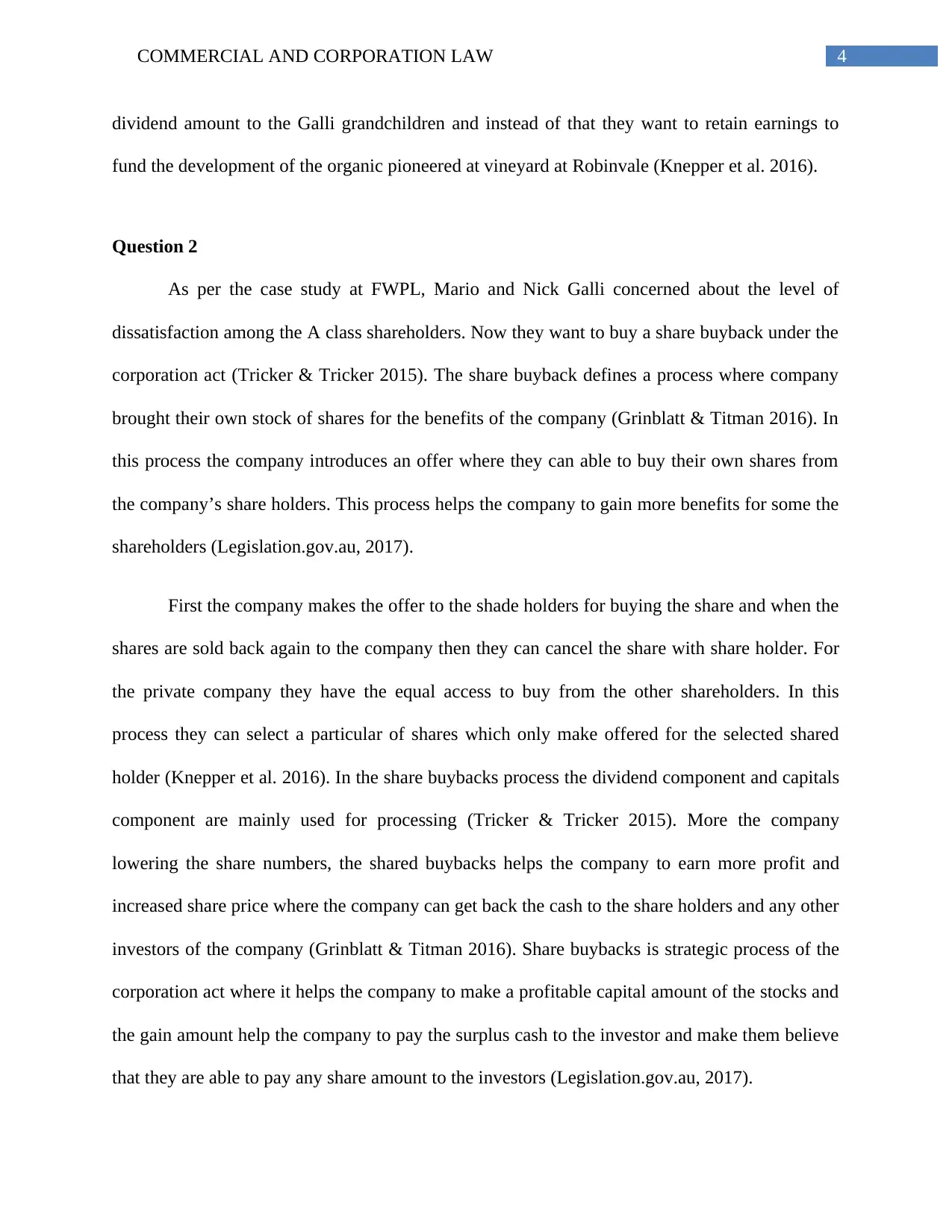
4COMMERCIAL AND CORPORATION LAW
dividend amount to the Galli grandchildren and instead of that they want to retain earnings to
fund the development of the organic pioneered at vineyard at Robinvale (Knepper et al. 2016).
Question 2
As per the case study at FWPL, Mario and Nick Galli concerned about the level of
dissatisfaction among the A class shareholders. Now they want to buy a share buyback under the
corporation act (Tricker & Tricker 2015). The share buyback defines a process where company
brought their own stock of shares for the benefits of the company (Grinblatt & Titman 2016). In
this process the company introduces an offer where they can able to buy their own shares from
the company’s share holders. This process helps the company to gain more benefits for some the
shareholders (Legislation.gov.au, 2017).
First the company makes the offer to the shade holders for buying the share and when the
shares are sold back again to the company then they can cancel the share with share holder. For
the private company they have the equal access to buy from the other shareholders. In this
process they can select a particular of shares which only make offered for the selected shared
holder (Knepper et al. 2016). In the share buybacks process the dividend component and capitals
component are mainly used for processing (Tricker & Tricker 2015). More the company
lowering the share numbers, the shared buybacks helps the company to earn more profit and
increased share price where the company can get back the cash to the share holders and any other
investors of the company (Grinblatt & Titman 2016). Share buybacks is strategic process of the
corporation act where it helps the company to make a profitable capital amount of the stocks and
the gain amount help the company to pay the surplus cash to the investor and make them believe
that they are able to pay any share amount to the investors (Legislation.gov.au, 2017).
dividend amount to the Galli grandchildren and instead of that they want to retain earnings to
fund the development of the organic pioneered at vineyard at Robinvale (Knepper et al. 2016).
Question 2
As per the case study at FWPL, Mario and Nick Galli concerned about the level of
dissatisfaction among the A class shareholders. Now they want to buy a share buyback under the
corporation act (Tricker & Tricker 2015). The share buyback defines a process where company
brought their own stock of shares for the benefits of the company (Grinblatt & Titman 2016). In
this process the company introduces an offer where they can able to buy their own shares from
the company’s share holders. This process helps the company to gain more benefits for some the
shareholders (Legislation.gov.au, 2017).
First the company makes the offer to the shade holders for buying the share and when the
shares are sold back again to the company then they can cancel the share with share holder. For
the private company they have the equal access to buy from the other shareholders. In this
process they can select a particular of shares which only make offered for the selected shared
holder (Knepper et al. 2016). In the share buybacks process the dividend component and capitals
component are mainly used for processing (Tricker & Tricker 2015). More the company
lowering the share numbers, the shared buybacks helps the company to earn more profit and
increased share price where the company can get back the cash to the share holders and any other
investors of the company (Grinblatt & Titman 2016). Share buybacks is strategic process of the
corporation act where it helps the company to make a profitable capital amount of the stocks and
the gain amount help the company to pay the surplus cash to the investor and make them believe
that they are able to pay any share amount to the investors (Legislation.gov.au, 2017).
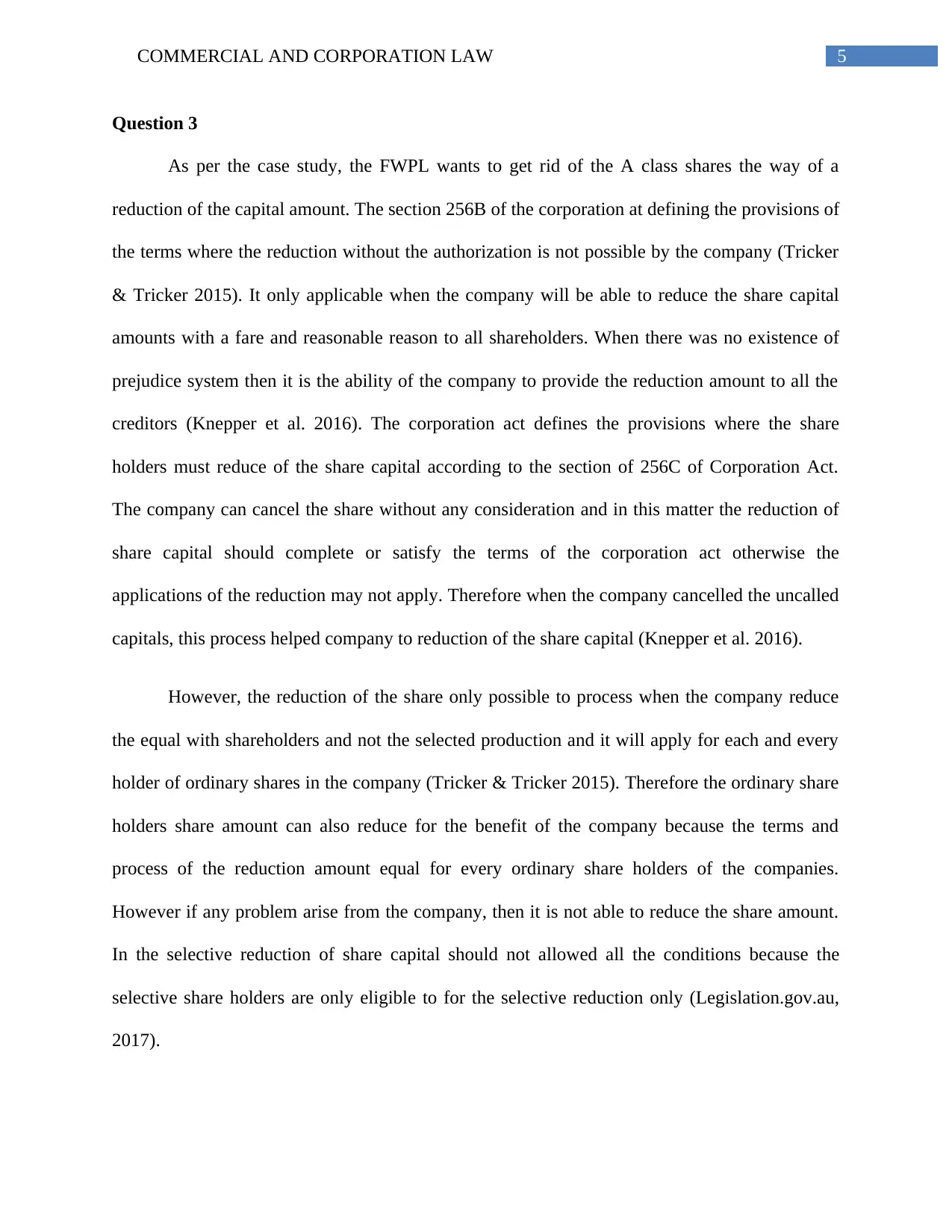
5COMMERCIAL AND CORPORATION LAW
Question 3
As per the case study, the FWPL wants to get rid of the A class shares the way of a
reduction of the capital amount. The section 256B of the corporation at defining the provisions of
the terms where the reduction without the authorization is not possible by the company (Tricker
& Tricker 2015). It only applicable when the company will be able to reduce the share capital
amounts with a fare and reasonable reason to all shareholders. When there was no existence of
prejudice system then it is the ability of the company to provide the reduction amount to all the
creditors (Knepper et al. 2016). The corporation act defines the provisions where the share
holders must reduce of the share capital according to the section of 256C of Corporation Act.
The company can cancel the share without any consideration and in this matter the reduction of
share capital should complete or satisfy the terms of the corporation act otherwise the
applications of the reduction may not apply. Therefore when the company cancelled the uncalled
capitals, this process helped company to reduction of the share capital (Knepper et al. 2016).
However, the reduction of the share only possible to process when the company reduce
the equal with shareholders and not the selected production and it will apply for each and every
holder of ordinary shares in the company (Tricker & Tricker 2015). Therefore the ordinary share
holders share amount can also reduce for the benefit of the company because the terms and
process of the reduction amount equal for every ordinary share holders of the companies.
However if any problem arise from the company, then it is not able to reduce the share amount.
In the selective reduction of share capital should not allowed all the conditions because the
selective share holders are only eligible to for the selective reduction only (Legislation.gov.au,
2017).
Question 3
As per the case study, the FWPL wants to get rid of the A class shares the way of a
reduction of the capital amount. The section 256B of the corporation at defining the provisions of
the terms where the reduction without the authorization is not possible by the company (Tricker
& Tricker 2015). It only applicable when the company will be able to reduce the share capital
amounts with a fare and reasonable reason to all shareholders. When there was no existence of
prejudice system then it is the ability of the company to provide the reduction amount to all the
creditors (Knepper et al. 2016). The corporation act defines the provisions where the share
holders must reduce of the share capital according to the section of 256C of Corporation Act.
The company can cancel the share without any consideration and in this matter the reduction of
share capital should complete or satisfy the terms of the corporation act otherwise the
applications of the reduction may not apply. Therefore when the company cancelled the uncalled
capitals, this process helped company to reduction of the share capital (Knepper et al. 2016).
However, the reduction of the share only possible to process when the company reduce
the equal with shareholders and not the selected production and it will apply for each and every
holder of ordinary shares in the company (Tricker & Tricker 2015). Therefore the ordinary share
holders share amount can also reduce for the benefit of the company because the terms and
process of the reduction amount equal for every ordinary share holders of the companies.
However if any problem arise from the company, then it is not able to reduce the share amount.
In the selective reduction of share capital should not allowed all the conditions because the
selective share holders are only eligible to for the selective reduction only (Legislation.gov.au,
2017).
⊘ This is a preview!⊘
Do you want full access?
Subscribe today to unlock all pages.

Trusted by 1+ million students worldwide
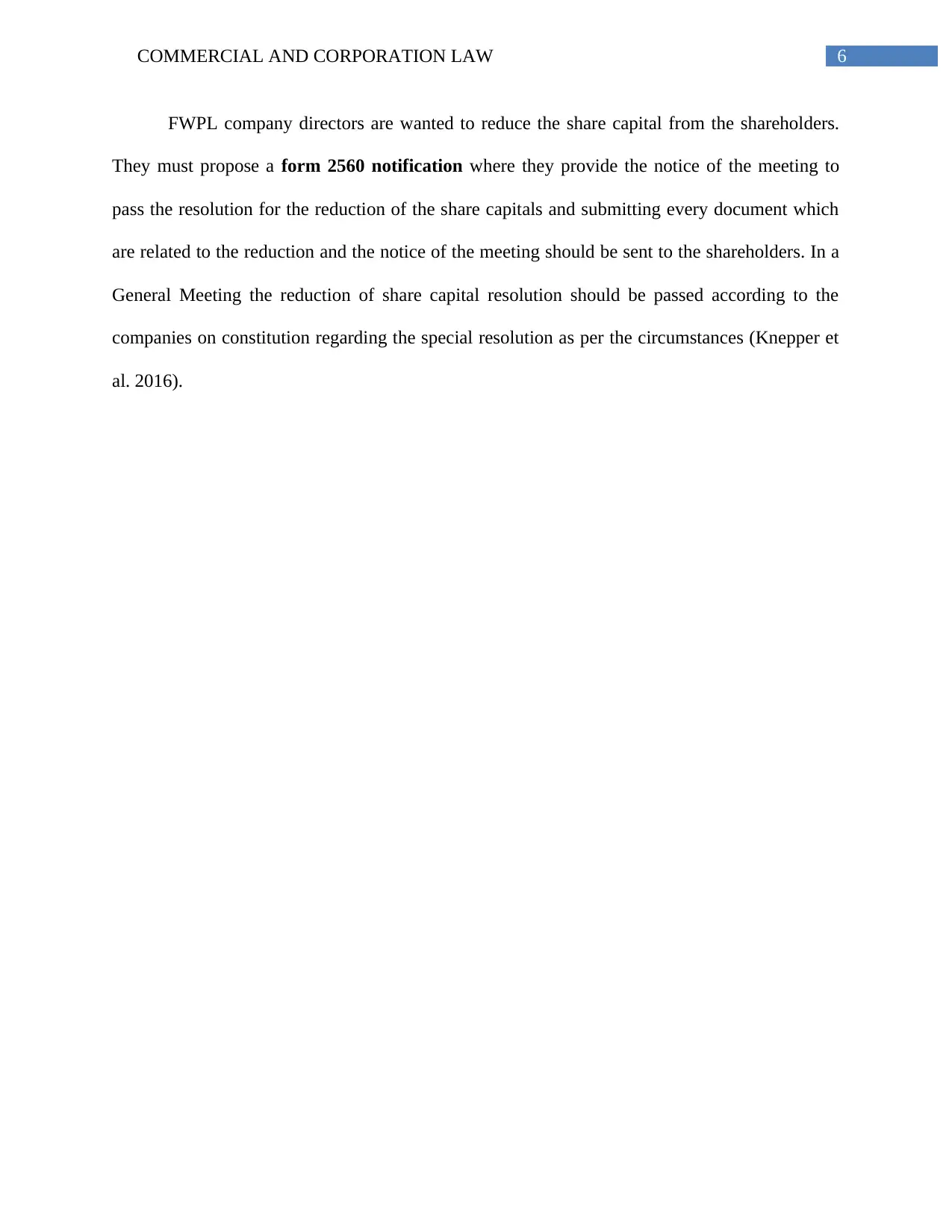
6COMMERCIAL AND CORPORATION LAW
FWPL company directors are wanted to reduce the share capital from the shareholders.
They must propose a form 2560 notification where they provide the notice of the meeting to
pass the resolution for the reduction of the share capitals and submitting every document which
are related to the reduction and the notice of the meeting should be sent to the shareholders. In a
General Meeting the reduction of share capital resolution should be passed according to the
companies on constitution regarding the special resolution as per the circumstances (Knepper et
al. 2016).
FWPL company directors are wanted to reduce the share capital from the shareholders.
They must propose a form 2560 notification where they provide the notice of the meeting to
pass the resolution for the reduction of the share capitals and submitting every document which
are related to the reduction and the notice of the meeting should be sent to the shareholders. In a
General Meeting the reduction of share capital resolution should be passed according to the
companies on constitution regarding the special resolution as per the circumstances (Knepper et
al. 2016).
Paraphrase This Document
Need a fresh take? Get an instant paraphrase of this document with our AI Paraphraser
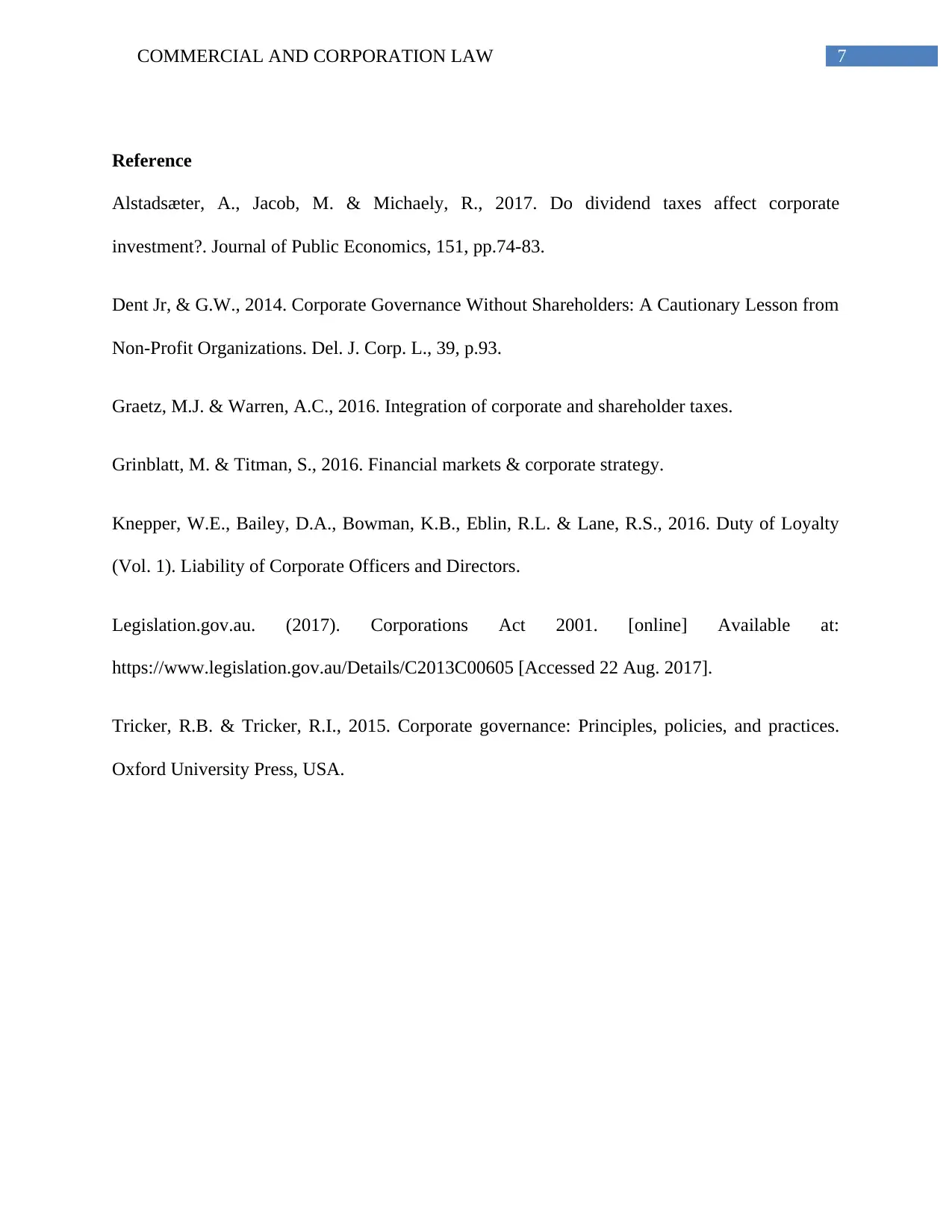
7COMMERCIAL AND CORPORATION LAW
Reference
Alstadsæter, A., Jacob, M. & Michaely, R., 2017. Do dividend taxes affect corporate
investment?. Journal of Public Economics, 151, pp.74-83.
Dent Jr, & G.W., 2014. Corporate Governance Without Shareholders: A Cautionary Lesson from
Non-Profit Organizations. Del. J. Corp. L., 39, p.93.
Graetz, M.J. & Warren, A.C., 2016. Integration of corporate and shareholder taxes.
Grinblatt, M. & Titman, S., 2016. Financial markets & corporate strategy.
Knepper, W.E., Bailey, D.A., Bowman, K.B., Eblin, R.L. & Lane, R.S., 2016. Duty of Loyalty
(Vol. 1). Liability of Corporate Officers and Directors.
Legislation.gov.au. (2017). Corporations Act 2001. [online] Available at:
https://www.legislation.gov.au/Details/C2013C00605 [Accessed 22 Aug. 2017].
Tricker, R.B. & Tricker, R.I., 2015. Corporate governance: Principles, policies, and practices.
Oxford University Press, USA.
Reference
Alstadsæter, A., Jacob, M. & Michaely, R., 2017. Do dividend taxes affect corporate
investment?. Journal of Public Economics, 151, pp.74-83.
Dent Jr, & G.W., 2014. Corporate Governance Without Shareholders: A Cautionary Lesson from
Non-Profit Organizations. Del. J. Corp. L., 39, p.93.
Graetz, M.J. & Warren, A.C., 2016. Integration of corporate and shareholder taxes.
Grinblatt, M. & Titman, S., 2016. Financial markets & corporate strategy.
Knepper, W.E., Bailey, D.A., Bowman, K.B., Eblin, R.L. & Lane, R.S., 2016. Duty of Loyalty
(Vol. 1). Liability of Corporate Officers and Directors.
Legislation.gov.au. (2017). Corporations Act 2001. [online] Available at:
https://www.legislation.gov.au/Details/C2013C00605 [Accessed 22 Aug. 2017].
Tricker, R.B. & Tricker, R.I., 2015. Corporate governance: Principles, policies, and practices.
Oxford University Press, USA.
1 out of 8
Related Documents
Your All-in-One AI-Powered Toolkit for Academic Success.
+13062052269
info@desklib.com
Available 24*7 on WhatsApp / Email
![[object Object]](/_next/static/media/star-bottom.7253800d.svg)
Unlock your academic potential
Copyright © 2020–2025 A2Z Services. All Rights Reserved. Developed and managed by ZUCOL.





